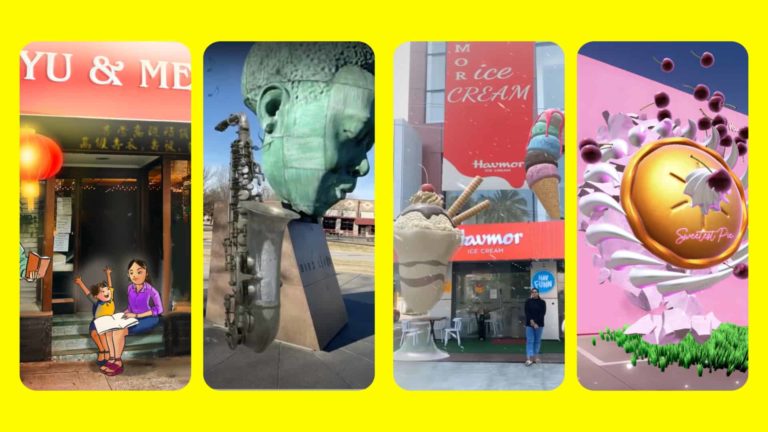
AR hasn’t demonstrated the world-changing capabilities that were touted in its circa-2017 hype cycle, but it’s finding success in specific areas. Those include enterprise productivity and brand marketing, both of which were examined in recent ARtillery Intelligence reports.
Zeroing in on AR marketing, one company leading the way in providing – and generating meaningful revenue from – AR marketing is Snap. Congruent with its “camera-company” label, it made an early commitment to social AR lenses and continues to double down on the technology.
In fact, of all the players cultivating consumer-based AR products and business models, none have achieved the traction of Snap. Though social media competitors like Meta and TikTok have greater overall reach, AR lenses are more of a central priority and “north star” for Snap.
This includes 6 billion AR lens engagements per day, among other metrics. But what are the lessons and takeaways? What’s Snap doing right in terms of product and platform development? This is the topic of a recent ARtillery Intelligence report, which we’ve excerpted below.
Crowdsourcing Creativity
Picking up where we left off in the last part of this series, an ongoing theme is Snap’s efforts to empower developers with tools to build engaging lenses. And one place it’s done that is Custom Landmarkers, letting creators build their own versions of Snap’s popular lens format.
As background, Landmarkers are lenses that are anchored to specific places to bring them to life. This puts them in an opportune subsector of AR that focuses on geospatial experiences. As we examined last week, geo-relevance is a value driver in everything from search to social media.
This principle will apply to AR, perhaps even more than earlier mediums, given that its inherent promise is to digitally enhance the physical world. Points of interest and businesses are a key part of that formula, similar to the value that drives real estate (location, location location).
Along with AR leaders like Niantic, Snap is keen on this opportunity, which brings us back to custom Landmarkers. This puts tools in AR creators’ hands to create their own Landmarkers. It builds on the 30+ Landmarkers Snap has created, scaling the program by crowdsourcing it.
Context & Dimension
Going deeper on Custom Landmarkers, they offer a framework for lens creators to scan a given location, then create a lens that is endemic to that place and digitally anchored to it. This scanning process helps developers create lenses that integrate contextually and dimensionally.
The scanning process also serves as a trigger for future lens activation. Once scanned, Snap can recognize that place and tee up the right lenses. This is a key concept of the AR cloud – a mesh of geo-anchored data that lets AR devices evoke the right content when and where relevant.
But because that’s still an advanced concept, Snap is offering Snapcodes that creators can apply so that users can activate Landmarkers on-site. This provides a familiar technology that can serve as a bridge to more advanced AR – a key principle that underpins Snap’s AR efforts.
Boiling this down to a practical example, a theme park can create Landmarkers around their grounds and plant Snapcodes accordingly. The latter can both launch the intended lens and serve as a sort of nudge for users to pull out their phones and fire up Snapchat to see something new.
Flavor & Flair
Use cases can also involve local flavor and flair. BLNK founder and creative director Michael Nicoll told us during an interview that he’s been working with Custom Landmarkers to create geo-anchored artistic fare around Los Angeles – think virtual street art with an interactive kick.
Nicoll’s goal is to also bring this flavor of lenses to his entertainment clients. There, it can open up a new dimension to any marketing mix. This could include everything from consumer brands to recording artists, to lens activations at venues like L.A.’s Crypto.com Arena.
Speaking of Nicoll and AR creators, Custom Landmarkers once again invoke a key theme: crowdsourcing innovation and creativity. Among other things, this will continue to help Snap scale and support local art as head of platform partnerships Sophia Dominguez told us last year.
“Our approach has always been to turn over our AR technology to our community of more than 250,000* creators around the world through Lens Studio,” she said. “Now, AR creators and developers can build anchored, location-based AR experiences to local places they care about.”
*Since this quote was captured, the number of Snapchat lens creators has grown to 300,000.

